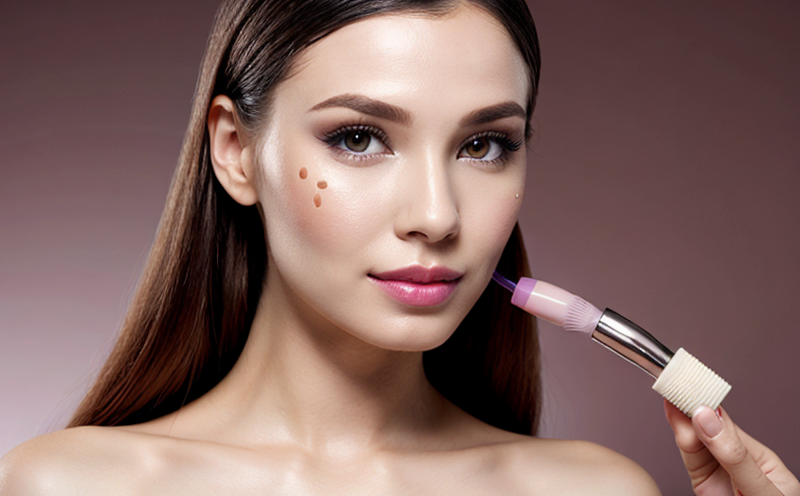In Vitro Tear Film Stability Testing in Cosmetic Sprays
The development of cosmetic sprays involves a complex interplay between formulation chemistry and product performance. Ensuring that these products are safe for use is paramount, especially when considering the intimate contact they have with the ocular surface. One critical aspect of safety evaluation is assessing how these formulations interact with the tear film to prevent potential adverse effects on ocular health.
The in vitro approach to evaluating tear film stability offers several advantages over traditional in vivo methods. These include reduced animal use, enhanced reproducibility, and more controlled conditions that can better mimic real-world scenarios. In this context, the in vitro tear film stability test specifically examines how a cosmetic spray interacts with the tear film under various environmental and physiological conditions.
The procedure involves exposing a reconstructed human corneal epithelium (rHCE) model to the cosmetic spray. This model is designed to replicate the behavior of living tissue at the ocular surface, allowing for a more accurate assessment of potential irritancy or sensitization risks. By monitoring changes in tear film properties such as viscosity and pH levels post-exposure, researchers can determine whether the product might disrupt the natural balance of the ocular surface.
The methodology also includes an evaluation of the stability of the tear film over time after exposure to the test substance. This helps identify any immediate or delayed effects that could indicate a risk for consumers using the cosmetic spray regularly. Additionally, this type of testing can provide insights into how different ingredients within the formulation contribute to overall product safety.
One key challenge in conducting these tests is ensuring accurate representation of real-world conditions while maintaining ethical standards regarding animal welfare. Advances in technology have led to sophisticated models and apparatus that allow for precise simulation of both natural tear film dynamics and environmental factors like humidity, temperature, and light exposure.
| Parameter | Description |
|---|---|
| Tear Film Viscosity | The consistency of the tear film before and after exposure to the cosmetic spray is measured using a rheometer. Changes in viscosity can indicate alterations in tear film structure. |
| Surface Tension | This measures how easily the tear film spreads over the ocular surface, which affects its ability to protect against microbial invasion. |
| Osmolarity Levels | The osmotic pressure of the tear film is assessed post-exposure. Significant changes may suggest disruption in electrolyte balance crucial for maintaining healthy tear production. |
| Corneal Epithelium Integrity | A microscopic examination evaluates any damage to the corneal epithelium following exposure, indicative of potential irritation or sensitization issues. |
In conclusion, in vitro tear film stability testing represents a significant advancement in cosmetic safety evaluation. It provides valuable data on product performance without compromising ethical standards or exposing animals to unnecessary harm. As regulatory bodies continue to push for more humane testing methods, this approach will play an increasingly important role in ensuring that new cosmetic products meet rigorous safety requirements.
Scope and Methodology
The scope of the in vitro tear film stability test encompasses several key aspects aimed at evaluating a cosmetic spray’s interaction with the ocular surface. This includes assessing the impact on tear film properties such as viscosity, pH levels, osmolarity, and corneal epithelium integrity.
Reconstruction of Human Corneal Epithelium (rHCE): A model is created to simulate the living tissue at the ocular surface. This provides a controlled environment for testing without directly involving actual human subjects.
Exposure to Cosmetic Spray: The rHCE model is exposed to different formulations of cosmetic sprays under varying conditions, including temperature and humidity levels that mimic real-world usage.
Tear Film Property Evaluation:
Viscosity Measurement: Using a rheometer, the consistency of the tear film before and after exposure is measured.
Surface Tension Assessment: The ease with which the tear film spreads over the ocular surface is evaluated to assess its protective capabilities against microbial invasion.
Osmolarity Levels Determination: Changes in electrolyte balance, critical for healthy tear production, are monitored post-exposure.
Corneal Epithelium Integrity Examination:
Microscopic Analysis: Any damage to the corneal epithelium following exposure is examined under a microscope. This helps in identifying potential irritancy or sensitization risks.
Fluorescein Staining: A fluorescein dye is applied to highlight any areas of compromised tissue, providing visual evidence for further analysis.
The results from these evaluations are then compiled into comprehensive reports that detail the behavior and effects of each cosmetic spray under different conditions. These insights not only help manufacturers ensure product safety but also guide them in making informed decisions about ingredient selection and formulation adjustments to enhance overall efficacy while maintaining high standards of ocular health.
Benefits
Reduces animal use: By providing an alternative to traditional in vivo testing methods, it supports more ethical practices.
Increased reproducibility: Controlled laboratory conditions ensure consistent results across multiple tests.
Better simulation of real-world conditions: The ability to adjust factors such as temperature and humidity allows for a closer approximation of actual usage scenarios.
Enhanced safety evaluation: Detailed assessment of tear film properties helps identify potential risks early in the development process.
Quality and Reliability Assurance
The reliability of our in vitro tear film stability testing is ensured through adherence to strict quality control measures. Each test follows standardized protocols laid out by relevant international standards, such as ISO 16029-8, ensuring consistency and accuracy.
We employ advanced instrumentation and methodologies that are regularly calibrated and validated against known reference materials. Our team of experienced scientists conducts rigorous validation studies to confirm the reliability of our models and ensure they accurately reflect real-world ocular surface conditions.
Furthermore, we maintain strict quality assurance processes throughout every stage of testing, from sample preparation to data analysis. This includes regular audits and internal reviews by independent experts to verify adherence to best practices and international standards.
The combination of cutting-edge technology, experienced personnel, and stringent quality controls guarantees that our clients receive reliable, high-quality results they can trust when making important decisions about their cosmetic products’ safety and efficacy.





